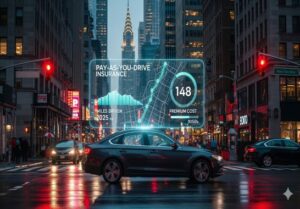
Car insurance is a necessity for every driver in New York City, but in 2025, policies are evolving to become smarter, more flexible, and cost-efficient. One of the most talked-about trends this year is Usage-Based Car Insurance (UBI), also known as Pay-As-You-Drive (PAYD) insurance. If you’re looking to save money on Car Insurance in NYC, understanding how usage-based policies work, and whether they fit your driving habits, can be a game-changer.
What Is Usage-Based Car Insurance?
Traditional car insurance policies calculate premiums based on general factors like age, vehicle type, location, and driving history. Usage-based car insurance, on the other hand, tracks your actual driving behavior through a telematics device, mobile app, or onboard vehicle system. The insurer collects data such as:
-
Miles driven
-
Driving times (day vs. night)
-
Acceleration and braking patterns
-
Speeding occurrences
-
Location patterns (city vs. highway)
Premiums are then adjusted according to how safely and frequently you drive. Simply put, the less and safer you drive, the less you pay. This model can be particularly beneficial in a busy city like NYC, where traffic congestion often means lower average speeds and shorter trips.
Why Usage-Based Car Insurance Is Gaining Popularity in NYC
There are several reasons why NYC drivers are increasingly turning to Pay-As-You-Drive Car Insurance:
1. High Cost of Traditional Insurance
Car insurance rates in NYC are among the highest in the United States due to dense traffic, high accident rates, and expensive medical claims. Usage-based insurance offers a practical way to reduce premiums for low-mileage and safe drivers.
2. Personalized Premiums
Instead of paying a flat rate, your premium reflects your actual driving habits. This personalization rewards responsible driving and discourages risky behavior.
3. Incentives for Safe Driving
Many insurers offer discounts or cashback rewards to drivers who demonstrate safe driving habits. Some programs even gamify the process, allowing drivers to earn badges or points.
4. Environmental Benefits
Driving less also reduces your carbon footprint. For eco-conscious NYC residents, usage-based insurance indirectly encourages greener commuting practices.
How Pay-As-You-Drive Works
Step 1: Sign Up With a Participating Insurer
Several top insurers in NYC now offer UBI policies. You’ll need to select a plan and authorize the insurer to monitor your driving.
Step 2: Install the Tracking Device or App
Most insurers provide one of the following:
-
OBD-II Device: Plugs into your car’s diagnostic port.
-
Mobile App: Uses GPS and accelerometer data from your smartphone.
-
Telematics System: Pre-installed in newer vehicles.
Step 3: Drive Normally
The device collects data on your trips. Some programs allow drivers to see their own driving scores, so they can improve behavior over time.
Step 4: Adjust Premiums Based on Driving
Insurers calculate discounts based on miles driven, adherence to speed limits, braking habits, and time of day. Premiums are usually adjusted monthly, quarterly, or at policy renewal.
Benefits of Usage-Based Car Insurance in NYC
1. Cost Savings
The most obvious benefit is potential savings. Low-mileage drivers who avoid rush-hour commuting or long highway trips can see significant reductions—sometimes up to 30–50% compared to traditional premiums.
2. Transparency
Drivers gain insight into how insurers calculate rates. Unlike traditional insurance, where premiums may feel arbitrary, usage-based insurance shows exactly how behavior impacts cost.
3. Flexibility
Usage-based policies often allow you to adjust coverage as your driving habits change. For instance, if you start commuting more, your premiums may rise—but if you reduce trips, your rates decrease.
4. Encourages Safer Driving
Since safe driving leads to lower premiums, drivers are naturally incentivized to adopt safer habits. This not only protects your wallet but also reduces accident risks.
Challenges and Considerations
While UBI offers significant benefits, there are a few considerations NYC drivers should keep in mind:
1. Privacy Concerns
Usage-based insurance requires tracking your driving data. While most insurers assure privacy, some drivers may feel uncomfortable sharing detailed location and driving behavior information.
2. Data Accuracy
Mobile apps can occasionally misread driving habits, such as sudden braking caused by traffic congestion rather than reckless driving. It’s important to monitor your scores and report discrepancies.
3. Limited Availability
Not all insurers in NYC offer UBI policies, and coverage options can vary. You may need to shop around for the best fit.
4. Potential Higher Costs for Aggressive Drivers
If you frequently speed, drive at night, or take long trips, UBI may result in higher premiums than a standard policy.
Top Usage-Based Car Insurance Programs in NYC (2025)
Several insurers have embraced usage-based policies. Some of the popular programs include:
| Insurer | Program Name | Key Features |
|---|---|---|
| State Farm | Drive Safe & Save | Mobile app, personalized discounts up to 30% |
| Allstate | Milewise | Pay per mile, flexible coverage options |
| Progressive | Snapshot | Tracks braking, acceleration, and mileage |
| GEICO | DriveEasy | Rewards safe driving, real-time feedback |
| Liberty Mutual | RightTrack | Monthly discount adjustments, driving feedback |
Tip: Always compare multiple providers to ensure you get the best combination of coverage, price, and data privacy.
How Much Can You Save With Pay-As-You-Drive Insurance?
Savings depend on your driving patterns. Here’s a realistic breakdown for NYC drivers:
-
Low-mileage drivers (<5,000 miles/year): 20–50% savings
-
Moderate drivers (5,000–10,000 miles/year): 10–20% savings
-
High-mileage drivers (>10,000 miles/year): Minimal savings; some may pay more
Example:
Maria drives only to work in Manhattan, totaling 6,000 miles per year. Her traditional insurance costs $2,200 annually. With usage-based insurance, her premium could drop to around $1,400–$1,700—a savings of $500–$800.
Tips for Maximizing Savings
-
Drive Less Frequently: Carpool, use public transit, or work from home when possible. Fewer miles equal lower premiums.
-
Avoid Risky Hours: Night driving increases accident probability and may raise costs.
-
Drive Safely: Smooth acceleration and braking improve your driving score.
-
Monitor Your Score: Use the insurer’s app to track performance and adjust habits.
-
Combine Discounts: Some insurers allow bundling with home insurance or other policies for additional savings.
The Future of Car Insurance in NYC
By 2025, usage-based car insurance is expected to become more sophisticated, leveraging AI and machine learning to create hyper-personalized policies. Some trends include:
-
Integration with Smart Cars: Vehicles with built-in telematics can automatically report driving data.
-
Dynamic Pricing: Real-time premium adjustments based on daily or weekly driving behavior.
-
Eco-Driving Incentives: Rewards for low-emission driving, electric vehicle use, and reduced congestion.
-
Enhanced Analytics: Insurers using AI to predict accidents and reward proactive risk reduction.
NYC drivers who adopt these policies early may enjoy lower costs, safer driving, and a competitive edge in the evolving auto insurance market.
Common Misconceptions About Usage-Based Insurance
Misconception 1: It’s Only for Safe Drivers
While safe driving maximizes savings, even average drivers can benefit from PAYD insurance if they drive fewer miles than the standard average.
Misconception 2: It Invades Privacy
Insurers only track driving behavior, not personal calls or messages. Many providers allow you to review the data collected for transparency.
Misconception 3: It’s More Expensive
Aggressive drivers may pay slightly more, but careful, low-mileage NYC drivers often save substantially compared to traditional insurance.
FAQ About Car Insurance in NYC and Usage-Based Policies
Q1: Is usage-based insurance available for all cars in NYC?
Yes, most vehicles can be insured under UBI programs, but newer models with built-in telematics may offer additional benefits.
Q2: Can I switch from traditional insurance to usage-based mid-policy?
Many insurers allow you to switch at renewal, but some may permit mid-term changes with updated premiums.
Q3: How is my driving score calculated?
Scores are based on miles driven, time of day, speed, acceleration, braking, and location patterns.
Q4: Are there any hidden fees?
Reputable insurers are transparent, but always read the policy details. Some may charge device installation or reporting fees.
Q5: Can I cancel if I don’t like the program?
Yes, most UBI policies allow cancellation and a return to traditional insurance at renewal.
Conclusion
If you’re looking for smarter, flexible, and cost-effective Car Insurance in NYC, usage-based policies are a compelling option in 2025. By paying according to your actual driving habits, you can save money, adopt safer driving behaviors, and even contribute to a greener city.
Before enrolling, consider your driving patterns, review multiple providers, and monitor your data carefully. For low-mileage, responsible drivers in NYC, Pay-As-You-Drive Car Insurance could be the key to significantly reducing annual premiums while maintaining comprehensive coverage.
Key Takeaways
-
Usage-Based Car Insurance = Pay for what you drive
-
Best for low-mileage and safe drivers in NYC
-
Rewards safe driving and responsible habits
-
Savings can range from 20–50% annually
-
Future trends include AI integration, eco-incentives, and dynamic pricing
For more guidance and up-to-date information on Car Insurance in NYC, visit New York City Auto Insurance and explore your best options today.
